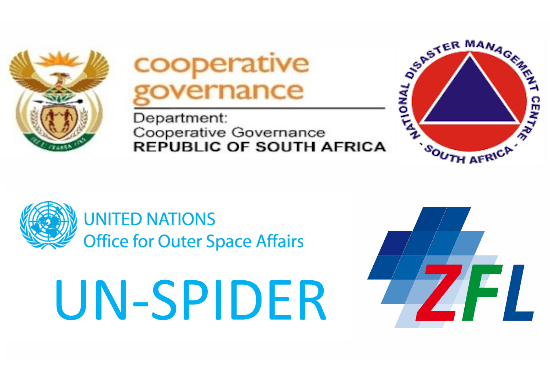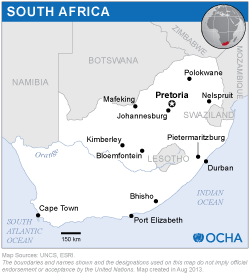To contribute to these efforts, UN-SPIDER and the Centre for Remote Sensing of Land Surfaces of the University of Bonn (ZFL) joined forces to organize an Institutional Strengthening Mission (ISM) to South Africa, which was coordinated with the NDMC. The mission was carried out in Pretoria from 8 – 12 May 2023. It included a High-Level Meeting on the first day (8 May), a three-day workshop (9 - 11 May 2023), and institutional visits to the South African National Space Agency (SANSA) (12 May 2023). The aims of the mission were:
- To increase synergies with the NDMC and with SANSA, and to link with stakeholder relations with Key South Africa public sector and other disaster management entities responsible for the management of flood and drought hazard.
- To facilitate the use of space-based information by NDMC, provincial branches of the NDMC, and other government agencies, in applications related to disaster preparedness, and response.
- To continue the implementation of the Flood GUIDE pilot project in South Africa.
The mission included the organization of the UN-SPIDER/NDMC/ ZFL Workshop "Space-based Solutions for floods and droughts in Southern Africa". The key aim of the workshop was to contribute to the efforts conducted by the NDMC, SANSA and other institutions of South Africa in the topics of disaster risk reduction, preparedness, and early warning systems. The aims of this workshop were:
- To take stock of efforts conducted by risk and disaster management institutions in South Africa on the use of space technologies and space-based information in disaster risk management, preparedness, response, and recovery efforts;
- To raise awareness regarding novel applications of satellite technologies in hazard mapping, early warning systems, and disaster response operations; including the Global Flood Awareness System (GLOFAS) and the Global Drought Observatory (GDO) of the Copernicus Programme.
- To raise awareness regarding the UN-SPIDER Recommended Practices for flood mapping using Sentinel 1 radar imagery.
The conduction of the workshop successfully allowed the organizational committee to reach a large audience of representatives of a variety of government agencies in South Africa, on both national and provincial level which contribute to disaster management efforts, and to showcase examples of mechanisms established by the space community to contribute to disaster response efforts worldwide.
With the institutional visits and interinstitutional meetings, the organizers were able to raise awareness about the benefits of the use of space technology and to encourage stronger links between several institutions and the NDMC. Furthermore, the visits to SANSA facilities facilitated an exchange of information between SANSA, NDMC and UN-SPIDER and were used to identify specific areas for future cooperation.


